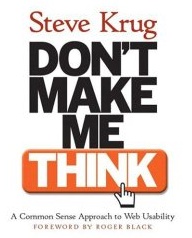Reading: Don't Make Me Think

Some useful takeaways from Don't Make Me Think (Steve Krug, 2000)[1]:
- Title of the book doesn't mean that you should assume your users are stupid, just that what you provide them should be self-evident as should any actions they can take.
- Making a user think exists in the large as well as in the small. For the former, providing a confusing and changing layout will force the user to think about every single action she takes. For the latter, using nonstandard terminology for standard actions makes her think just a half second -- for instance, using 'Quick Find' instead of 'Search'.
- Consistency is key. For instance, if a user clicks on a link for a resident that says 'Robert Rodriguez' and gets to a page titled 'Resident Actions' with only summary information about the resident in a small red bar at the top, we're making her think.
- People don't read instructions, so don't even provide them. Cut your text in half, then cut it in half again.
- People muddle through without reasoning a rational explanation of what they're doing or why it's progressing the way it is.
- People rarely (approaching never) use the paths through your site that you expect, and you need to design it such that someone can look at a page and figure out what it's for, what they can do with it, and how to get around the rest of the site.
- Make 'clickable things' obviously clickable; creating a design for subtlety won't work, unless (maybe) you're designing a site whose sole audience is graphic designers.
- Krug's second law of usability: "It doesn't matter how many times I have to click, as long as each click is a mindless, unambiguous choice."
- Testing is crucial and is valuable even in small doses, even if you only do a little of it. Focus groups are okay, but a one-on-one videotaped encounter with a user trying to get certain tasks done with your site is best. He has a script of how such an encounter might progress.
- Before-and-after examples are really useful, where he takes a site's page, explains what's wrong with it and then creates a new page in response.
- Focus is on e-commerce sites circa 2000, which means a lot of
current technology (like AJAX) doesn't come into play.
- It also means you get to see the pets.com and flooz sites again!)
- It also means you there's a good amount of text that doesn't translate well to an internal application built for a dedicated (work-time) audience. For instance, the chapter on what goes into the home page is mostly irrelevant. </ul> </li> </ul>
[1] I just noticed while digging up the link for this post that a second edition was published last year: doh! I don't know how much it's changed.
</ul>
Other stuff:
Previous: Back online!